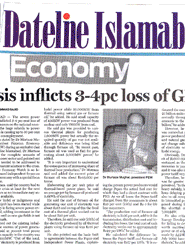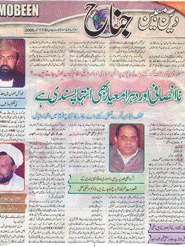Pakistan slides from ‘Water happy’ to ‘Water deficit’ country– PEW
Click here to View Printed Statements
The News
Daily Mail
Pakistan Times
Business Asia Weekly
Pakistan agriculture sector under threat and can lead to food insecurity
Water shortage will increase to 108 maf by 2013 and 151 maf by 2025 from the existing 40 maf shortfall
ISLAMABAD: Pakistan is rapidly marching towards a “water-deficit” country, as its availability has alarmingly dropped to about 1200 cubic meters now from 5650 cubic meters per person five decades ago, leading to the crises of energy, food supplies, high prices, climate change and troubled financial market. Water scarcity was a ‘potential threat’ to the agriculture sector that contributes about 21 per cent to the country’s gross domestic product (GDP) and employees about 45 per cent of the country’s labor force. Pakistan had the largest irrigation system, but water losses from the system were the highest in the World. The situation calls political and other leadership to be serious in building of small and big water storages, as to save future generation from the miseries and secure the country and its economy, the President of Pakistan Economy Watch (PEW) Dr. Murtaza Mughal said here.
“Per person water availability has declined to 1200 cubic meters at present from 5,650 cubic meters in 1960. In 2025, not more than 1,000 cubic meters will be available per person, making the country a water-scarce area,” Dr. Mughal said.
Pakistani population is increasing, while its agricultural growth is reducing due to water shortages. He proposed, “We must bring more land under cultivation to keep up the pace of agricultural growth comparable to population growth. In order to achieve the required growth targets in agriculture, we needed an estimated amount of 149 million acre feet (maf) in 2000 and will need 215 maf in year 2013 and about 277 maf by year 2025”.
This scenario warns that Pakistan already has slide from a “water happy” country to a “water scarce” country in 1994 and already shortage of over 40 maf persists, which may increase to a shortage of 108 maf and 151 maf by years 2013 and 2025.
He said, “Higher water productivity, with its efficient use was vital for sustainable agriculture development that could lead to poverty alleviation through increased productivity, profitability, enhanced food security, and large-scale employment generation”.
Every year, Pakistan is losing about ‘50 percent’ of its water, particularly in areas where quality of ground water is poor and not usable. Among the 25 most populous countries in 2009, South Africa, Egypt, and Pakistan were the most water-limited nations. However, India and China were not far behind with per capita renewable water resources of only 1,600 and 2,100 cubic meters per year.
Citing the World Bank’s report of 2006, he said Pakistan was fast moving from being a water-stressed country to a water-scarce country, mainly because of its high population growth, over-exploitation of ground water, pollution, poor repair in water infrastructures and financially no sustainability of water management system.
Interestingly, the country’s large parts have good soil, sunshine and excellent farmers and these can get much more value from the existing flows. Water being the most critical input for sustained agricultural productivity, economic development, and environmental protection, but in spite of abundant water resources, “we were afflicted with endemic low income, malnutrition, and low human development index.” He said.
Giving the examples of other countries, he said major European countries have up to twice as much renewable water resources per capita, ranging from 2,300 cubic meters in Germany to 3,000 cubic meters in France. The United States has far greater renewable water resources than China, India and major European countries. It has 9,800 cubic meters per person per year. By far the largest renewable water resources are reported from Brazil and the Russian Federation with 31,900 and 42,500 cubic meters per person per year.
پاکستان میں پانی کا بحران شدت اختیار کرتا جا رہا ہے
پانی کی کمی ملکی معیشت سمیت ہر شعبہ پر اثر انداز ہو رہی ہے۔ ملک خطرات سے دوچار
پاکستان کا نہری نظام دنیا میں بہترین، پانی کے ضیاں میں بھی سر فہرست
اسلام آباد پاکستان اکانومی واچ کے صدر ڈاکٹر مرتضیٰ مغل نے کہا کہ پاکستان میں پانی کا بحران شدت اختیار کرتا جا رہا ہے اور پانی کی کمی ملکی معیشت سمیت ہر شعبہ پر اثر انداز ہو رہی ہے جس سے ملک کا مستقبل خطرات سے دوچار ہو گیا ہے۔ زراعت، صنعت ، عوام اور جانوروں کے لئے پانی کی دستیابی ایک سنگین مسئلہ بن چکا ہے جا کی طرف فوری توجہ نہ دی گئی تو حالات خطرناک صورت اختیار کر لینگے۔پانچ دہائی قبل ایک فرد کے لئے 5650مکعب میٹر پانی دستیاب تھا جو اب گھٹ کر 1200مکعب میٹر رہ گیا ہے اور اس میں مزید کمی ہو رہی ہے۔ ڈاکٹر مرتضیٰ مغل نے کہا کہ زراعت کا شعبہ سب سے زیادہ خطرہ کی زر میں ہے جو مجموعی قومی پیداوار کا 21فیصد ہے جس سے 45فیصد افراد کا روزگار وابستہ ہے۔انھوں نے کہا کہ پاکستان کا نہری نظام دنیا میں بہترین مانا جاتا ہے مگر پانی کے ضیاں میں بھی ہم سر فہرست ہیں۔اگر صورتحال کی اصلاح نہ کی گئی تو 2025میں ہر فرد کے لئے صرف 1000مکعب میٹرپانی رہ جائے گا جسے دوسرے لفظوں میں قحط کہا جاتا ہے۔ڈاکٹر مغل نے کہا کہ ہمیں 2013میں 215ملین ایکڑ فٹ اور2025میں 277ملین ایکڑ فٹ پانی کی ضرورت ہو گی جس کے لئے ابھی سے منصوبہ بندی کرنے کی ضرورت ہے ورنہ پورا ملک انارکی کی لپیٹ میں آ جائے گا۔





